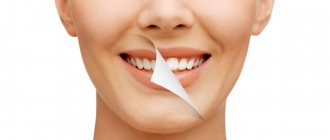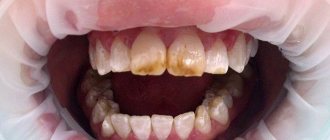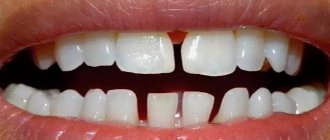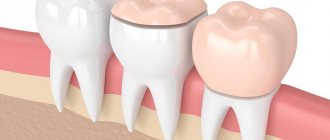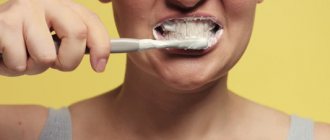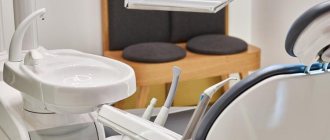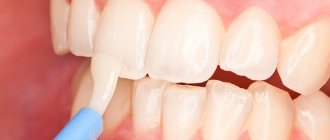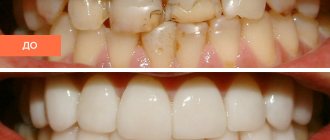Dental restoration with composite materials is an effective way to restore teeth quickly, safely and without pain.
example of composite artistic restoration of anterior teeth
Composite restoration is called aesthetic or artistic, since the restored tooth is in no way different from natural ones in color and shape. This method helps restore both the structure and function of a damaged tooth or several teeth at once using a safe composite or photopolymer. The procedure for tooth restoration with a composite takes place in the shortest possible period of time, the effectiveness of the method is high and there is a mandatory guarantee for all types of work performed.
Stages of composite restoration
The restoration method takes place in several stages.
- The first step is to administer local anesthesia if processing or grinding is necessary.
- The second point is preparing the tooth: cleaning it from plaque, fillings, leveling the surface.
- Next, the prepared tooth is isolated using a latex scarf with a hole for the tooth.
- Then, the restoration itself: layer-by-layer application of the composite material, followed by adjustment to the natural shape of the tooth and illuminated with a special lamp.
- At the last stage, final grinding, grinding, polishing is carried out - the tooth surface becomes ideal, smooth and naturally shiny.
The entire recovery procedure takes less than an hour.
What is restoration with composite materials?
Composite light-curing material is one of the most popular when carrying out therapeutic procedures and microprosthetics. So-called composite resins have been used in dentistry for more than half a century, but the composition of the materials has been constantly refined and changed to achieve optimal strength and aesthetics. Today, most clinics use hybrid composites, which are superior to previous generation materials in these indicators. The key property of any composite is excellent adhesiveness (contact of the material with the tooth tissue), which is achieved through polymerization. Simply put, under the influence of ultraviolet light the composite hardens, restoring the anatomical shape of the tooth.
Prices for services
| Tooth crown restoration or composite veneer | 7530 rub. |
| Filling with light-curing composite 1 surface | 3450 rub. |
| Filling with light-curing composite 2 surfaces | 4480 rub. |
| Filling with light-curing composite 3 surfaces | 6020 rub. |
| Installation of composite pins - per 1 tooth | 2710 rub. |
| Tab | 15700 rub. |
| Cementing a crown (inlay) onto a composite material | 1450 rub. |
To accurately determine the final price of treatment, sign up for a consultation at Dental Diamond and we will draw up a treatment plan. Use the phone numbers listed on the website or fill out the call back form.
Advantages and disadvantages of dental restoration with composite veneers
- Lower cost compared to ceramic veneers.
- They do not require deep preparation of tooth tissue.
- Good aesthetic indicators (the final result largely depends on the qualifications of the doctor).
- Simple replacement procedure.
- Less strong and durable compared to ceramic veneers.
- They require regular grinding (at least once every six months).
- Over time, dyes are absorbed, which affects aesthetics.
Who is undergoing the procedure?
Anyone can sign up for artistic restoration of the dentition or part of it. Common indications for restoration techniques:
- Cracks;
- Chips;
- Partial destruction;
- Carious lesions of varying neglect;
- Non-carious lesions that change the appearance of the dentition;
- Darkening of the enamel;
- The appearance of black spots on the teeth;
- Blackening or any other discoloration of the enamel.
If the client is dissatisfied with the external condition of the teeth, then Nurimed dentists will make an aesthetic restoration. At the same time, each patient is comprehensively examined, excluding contraindications to the procedure.
Features of composite restoration of anterior and chewing teeth
Speaking specifically about veneers, aesthetic restoration with composite material is used exclusively for front teeth. The primary task of overlays is to hide cosmetic and anatomical problems, as well as mechanical damage. This is why composite restoration of anterior teeth costs much more than a conventional filling, and many experts even consider the process of making veneers an art.
In the case of chewing teeth, the issue of aesthetics is already less significant: functionality comes to the fore. However, restoration of chewing teeth with composite material makes it possible to restore damaged dental tissues at a high aesthetic level. In this case, it is almost impossible to notice the filling on the tooth. Typically, dentists use macrophilic and hybrid composite materials when filling molars because they are considered stronger and more durable.
Advantages of the method
Our dental center prefers composite correction for patients due to a number of its advantages:
- An ideal aesthetic result, since it is possible to select a material that completely imitates natural tooth enamel.
- Helps to correct not only external beauty, but also restore chewing function. After restoration, a person can eat any food without fear of pain or discomfort.
- The correction speed is high. One visit to the dentist is enough to restore several teeth. Especially when it comes to a modernly equipped clinic.
- Allows you to preserve the maximum amount of healthy tissue. A very gentle option for restoring a smile.
- Moderate cost of the service. Despite a number of listed advantages, the price of restoration remains affordable to every client.
Contraindications.
Composite restoration, although it belongs to the section of aesthetic dentistry, is still a medical procedure and has a number of absolute contraindications. It cannot be performed if the patient is allergic to the materials used, has acute gum disease and has numerous caries. There are also several relative contraindications that should also be kept in mind:
- Destruction of tooth tissue by more than half.
- Absence of outer molars.
- Bruxism (teeth grinding).
- Abrasion of teeth.
- Malocclusion.
Alternative options
If you are not satisfied with the aesthetic performance and fragility of composites, then you can consider other restoration options:
- Ceramic, zirconium or metal-ceramic veneers. Unlike composite ones, they are installed only indirectly. Ceramic overlays are more aesthetically pleasing and are indistinguishable from natural enamel in shade and transparency. Some microprostheses can last 10 - 15 years or more. However, the price of one veneer starts from 25,000 rubles, and ultra-thin plates can cost 2–3 times more.
- Ceramic or metal inlays. A more reliable alternative to composite on a pin, but also more expensive. Most often used on chewing teeth.
- Crowns. Indicated for use if the outer part of the tooth is severely damaged. They are made from different materials: zirconium dioxide, metal-free ceramics, metal ceramics. Durable, wear-resistant, last for many years.
Advantages and disadvantages
For aesthetic restoration of teeth, different materials are used: photocomposites, ceramics, metal-ceramics and others. You can hide defects under a crown or onlays. Each material and method has its pros and cons.
Advantages of composite restoration:
- the aesthetics and integrity of the dental unit are restored in just one visit to the doctor, there is no need to make impressions and wait several weeks for the manufacture of microprostheses;
- minimal tissue preparation without depulpation;
- the possibility of performing the procedure without anesthesia, which is important for patients with allergies to anesthetics;
- the method is available for the reconstruction of primary teeth in children for whom crowns or veneers are not recommended because the bite is disturbed;
- good aesthetics, strength, wear resistance;
- large selection of shades;
- the material is plastic, easy to model, and working with it is not limited in time;
- there is no rehabilitation period;
- possibility of repair if chipped;
- cheaper than installing ceramic or metal-ceramic veneers.
After 2 - 3 years, the restoration fades and loses its former attractiveness. Composites are quite porous, so they absorb food coloring. However, if you follow the rules of hygiene and exclude foods with food dyes or pigments from your diet, the results will last longer.
The service life of a photopolymer restoration is several times shorter than that of veneers, crowns made of non-matella ceramics or metal ceramics, which is also a significant disadvantage.
Veneers: materials, advantages, features
Veneers are used in aesthetic dentistry to restore the frontal visible line of teeth. The basis of a Hollywood smile is created in a dental laboratory, where thin plates are made from impressions of the patient’s jaw. The onlays are fixed on the vestibular surface of the incisors and fangs after preliminary preparation - grinding of the enamel. The plates reliably cover the defective surface, creating an ideal line of snow-white teeth.
Veneers are usually divided according to materials and thickness:
- Ceramic - overlays are made using special equipment from medical ceramics or light-proof porcelain. The thickness of the products is 0.3-0.5 mm.
- Zirconium – zirconium dioxide veneers are biocompatible with human tissue, do not cause allergic reactions and perfectly imitate the color and texture of tooth enamel. Zirconium veneers are more expensive than ceramic ones, but they are superior to porcelain in strength and other characteristics.
- Ultrathin microprostheses are a separate category of products that do not require grinding of teeth during installation. Such linings are made from glass-ceramic or innovative compounds. The thinnest veneers are called lumineers or ultraneers. The thickness of dental plates is extremely small - from 0.2 mm.
Advantages of veneers
When comparing veneers and ceramic restorations, it is important for the patient to understand the advantages of each method. The choice of zirconium or ceramic overlays in the frontal area is a guarantee:
- Naturalness - ceramic crowns are indistinguishable from the patient’s own teeth, since during their manufacture they reproduce all the anatomical features of the enamel.
- Stability and strength - ceramic veneers can withstand severe chewing loads without damage and can easily withstand temperature changes.
- Chemical inertness - the materials used for veneering are not stained with food dyes and are not damaged by eating pickled and spicy foods.
- Gentle treatment - modern methods of grinding enamel allow doctors to work with the highest precision, so the removed tooth layer rarely exceeds 0.3 mm.
- Durability – indirect restorations are performed using particularly durable compounds, so the service life of veneers is long.
- Solutions to a number of orthodontic problems - an experienced doctor, using onlays, can easily correct external malocclusions, correct the shape and even the position of individual teeth.
Indications for indirect veneering
Dentists recommend ceramic veneers for the following conditions:
- Darkening or the appearance of streaks on tooth enamel - due to taking drugs of the tetracycline group or after using resorcinol-formalin for filling.
- Change in color of fillings placed on the front teeth - the incisors have become unaesthetic and noticeable when talking or smiling.
- Chips, cracks, disproportionate sizes of incisors, fangs - any distorted shape requires aesthetic restoration.
- Enlarged interdental gaps - diastemas, trema.
- Various congenital pathologies - wedge-shaped defect or other anomalies.
- Abrasion of tooth enamel - due to a lack of calcium in the body or due to various diseases.
- Pathologies or defects of tooth enamel - fluorosis, hyperplasia, erosion, necrosis.
Indications are the first thing an experienced dentist pays attention to. It is the condition of the oral cavity and individual units, the number and presence of aesthetic defects that determine the choice of treatment regimen.
Recommendations for care.
As soon as the specialist completes his work, you will be able to admire your irresistible smile, without any cosmetic defects. To maintain the results obtained for many years, you must follow a few simple rules. Their implementation will not be difficult for you at all, but at the same time your teeth will remain intact.
- Eliminate food and drinks containing dyes from your diet for a day after the procedure. In the future, also try to avoid consuming highly colored foods, carbonated water, red wine, coffee, etc.
- Don't forget about regular dental checkups and professional oral hygiene.
- On the first day after restoration, women should not wear bright red lipstick.
- The restored areas of the teeth may not withstand heavy loads, so you should not bite seeds, nuts, or chew sticky food.
- Use a toothbrush with soft bristles; it will avoid rapid abrasion of the filling material.
conclusions
The purpose of this article was to present the indications for minimally invasive treatment in addition to conservative orthodontic, prosthetic and implant treatment and to suggest possible treatment options. It should be noted that new treatments may fail when they exceed the indications for the use of specific materials and techniques. The described cases show that modern conservative dentistry has a wide range of indications and it is possible to treat a wider range of cases. Adhesive composite fiberglass bar bridges are an additional option for replacing a single missing tooth. They can also be used as high-quality, long-term provisional restorations before implantation.
Modern composites meet the expectations of the doctor and the patient. A combination of direct and indirect techniques for the restoration of anterior teeth has good prospects. It simplifies complex treatment, for example helping to create correct occlusion, and creates more effective and less cost-effective dentistry.
